ROAD BOOK Charming Lake Garda
A small travel guide for your self guided bike holiday
Charming Lake Garda • Road book INDEX
Introduction
Peschiera del Garda is one of the most lively and charming villages by Lake Garda, recently listed as a UNESCO Heritage Site thanks to its majestic Venetian walls that surrounds the old town. Peschiera del Garda is the perfect base for exploring the lake area by bike: the hilly countryside, the ancient villages, the immense vineyards and olive groves and the beautiful coastline.
Lake Garda is 368 mt² large and it is the biggest Italian lake. It has a glacial origin, the Northern side is surrounded by high mountains (the highest is Monte Baldo, 2.218 mt) and the southern side is surrounded by rolling moraine hills, where there is a predominant mediterranean climate and vegetation.
Lake Garda is also known as lake Benaco, from the latin word Benacus, that comes from the ancient Celt word bennach, that means “with many promontories”, as the shape of the lake. The current name Garda is from the Langobard time (VI-VIII century), when many forts and watchtowers – called warda – were built.
The lake has just a big tributary river in the northern side, river Sarca, and one big emissary river, river Mincio.
A curiosity: the small tributary river Aril, just 175 mt long, is considered the shortest in Italy. There are 5 islands: the largest one is Isola del Garda, where Saint Francis of Assisi founded a monastery in 1220.
The area of Lake Garda has always been strategically important and many people lived by its shores. Many prehistoric pile dwellings from Bronze Age were found close to the shores and now they are included among the UNESCO heritage sites. The Romans also lived by the lake and still nowadays we can visit the roman villas in Sirmione (Grotte di Catullo) and Desenzano, and the houses in Peschiera del Garda. After the Langobard invasions, the Roman Sacred Empire ruled over the area: the village of Lazise was the first independent comune in Italy.
During Medieval time, the Scaligeri family from Verona ruled over the eastern Lake Garda: they fortified many villages and built lots of castles. After the fall of the Scaligeri, Lake Garda was contended by the Visconti family (Milano) and Venice. Venice dominated the area until the arrival of Napoleon in 1796. The lands passed to the Austrian in 1815 and their domination lasted until 1866, when the area of Lake Garda (except the North side) was included into the Reign of Italy. Some of the most important battles were fought in its territory, in Santa Lucia, Solferino and San Martino, where it is still possible to find many celebratory monuments of the independence.
Departure and arrival of the three itineraries, Peschiera del Garda (10.500 inhabitants) has been recently listed as a UNESCO heritage sites thanks to the massive fortifications that surround the village. Besides of the many forts built on its territory, the village is surrounded by great Venetian walls, apparently unassailable, the water of Lake Garda and river Mincio.
The small city has a long history: in its territory many pile – dwelling houses from the Bronze Age – now UNESCO heritage site – were found. It has always been in a strategical position, between the Po Plain and the Alps, facing the lake Garda and crossed by river Mincio.
During the Roman age, the so-called Arilica had a strategical importance on the Via Gallica, a road that linked the main cities in the Po Plain: some remains of the old city are visible close to the church of San Martino Vescovo.
The building of the walls started during the Scaligeri time (XIII century). During the domination of Venice the city became one of the most important strongholds of the Republic: massive walls were built and still nowadays the main roads to enter in the city pass under the great gates built by the Venetian,
Porta Brescia and Porta Verona
Peschiera del Garda was a important city also during the Austrian and Napoleon occupation: many forts were built around the area, but they lost their importance after the annexion of Peschiera del Garda by the Kingdom of Italy in 1966.
Capuccini beach
The best walks are along the Canale di Mezzo, that divide the military section to the historical city centre, until the panoramic Voltoni bridge; on the patrol walkaway of Porta Brescia and on the promenade Mazzini until Cappuccini beach.
Sanctuary Madonna del Frassino
Not far from the city centre there’s a beautiful sanctuary dated XVI century, dedicated to the Virgin Mary. According to the tradition, here is where Virgin Mary showed up to a shepherd that was bitten by a snake and saved him.
Bike tour 1 • Sirmione
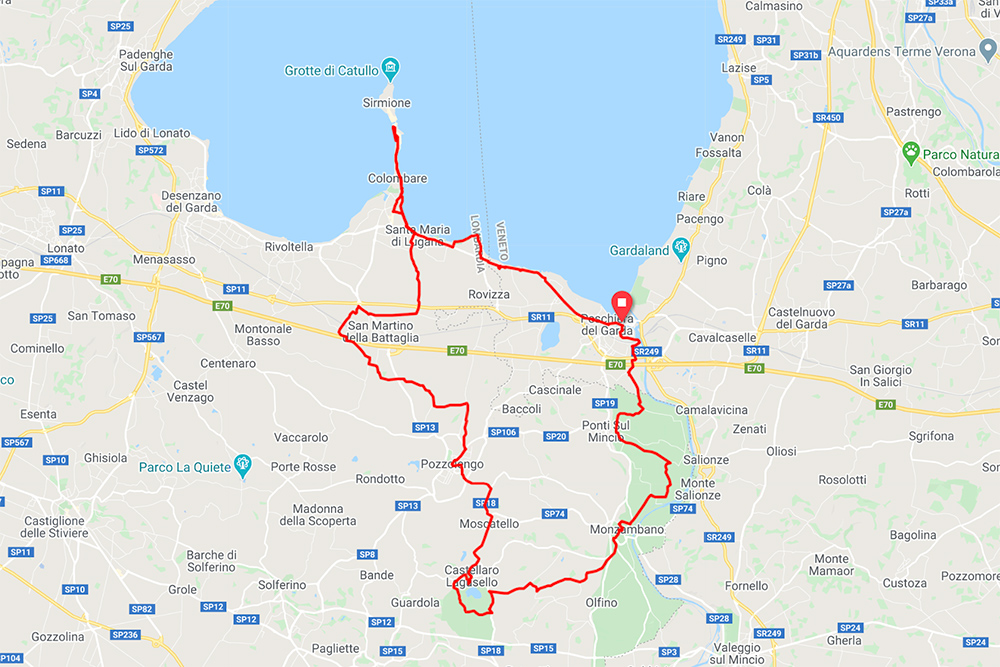
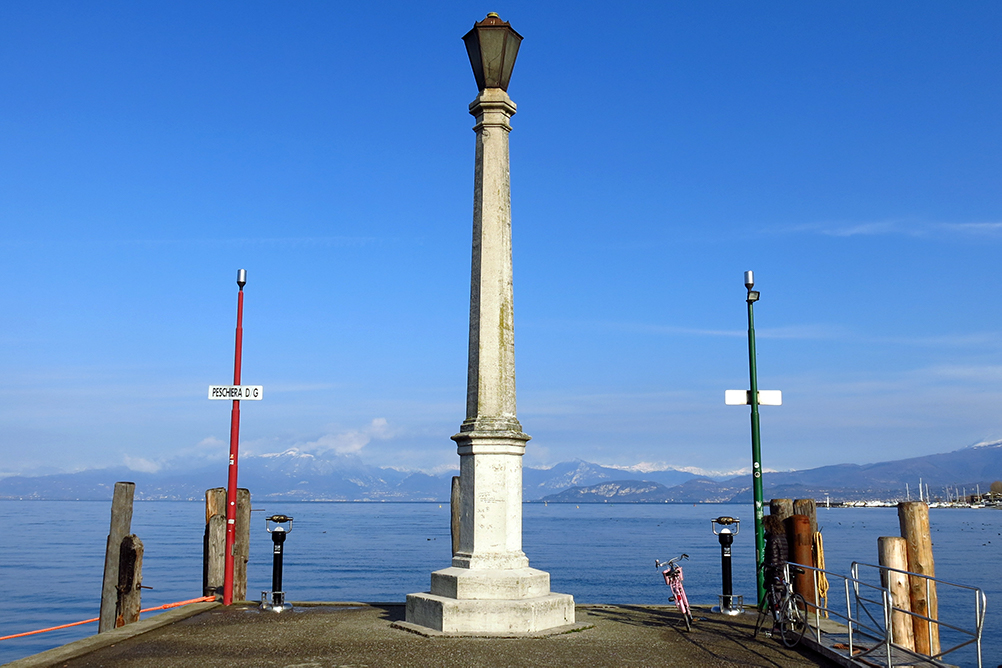
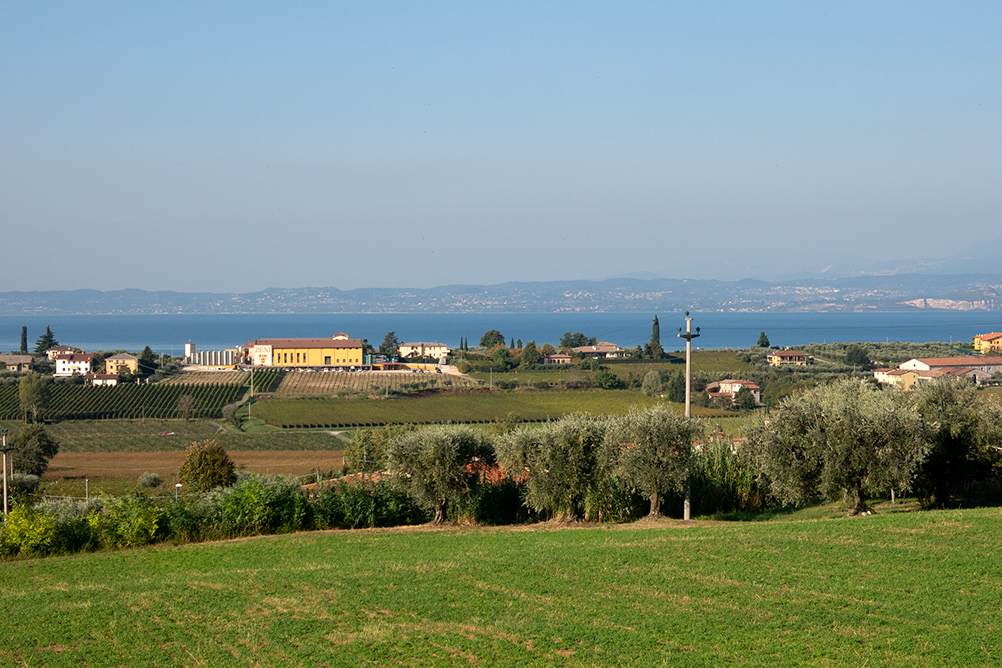
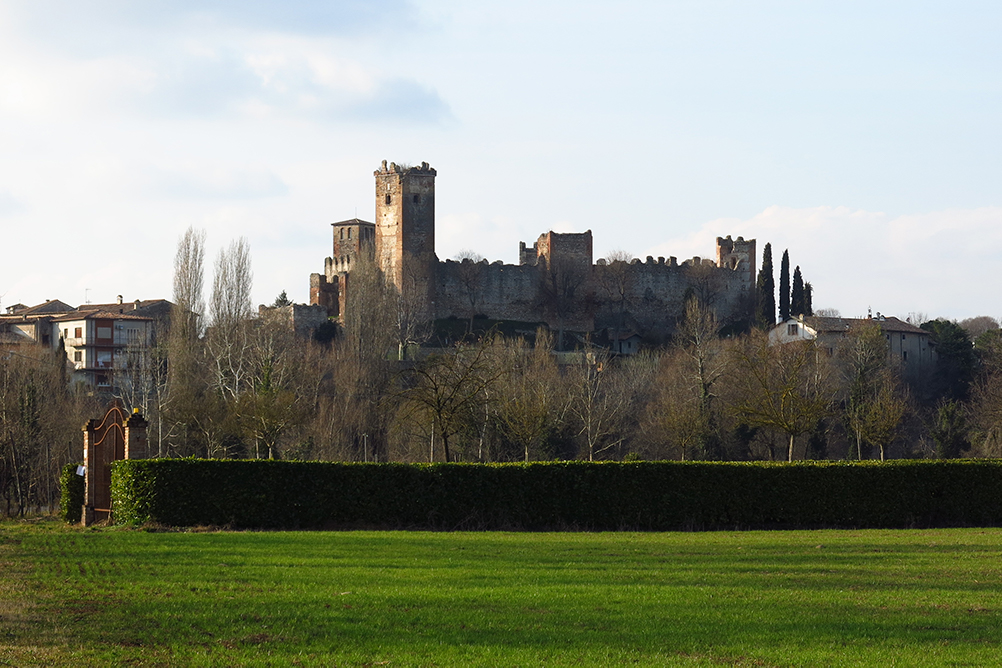
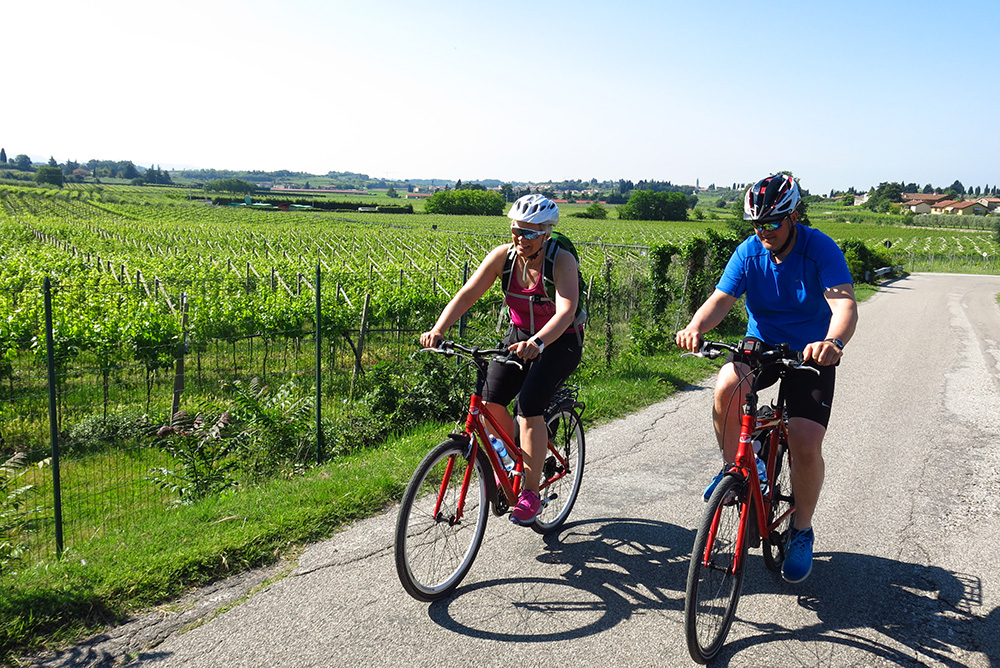
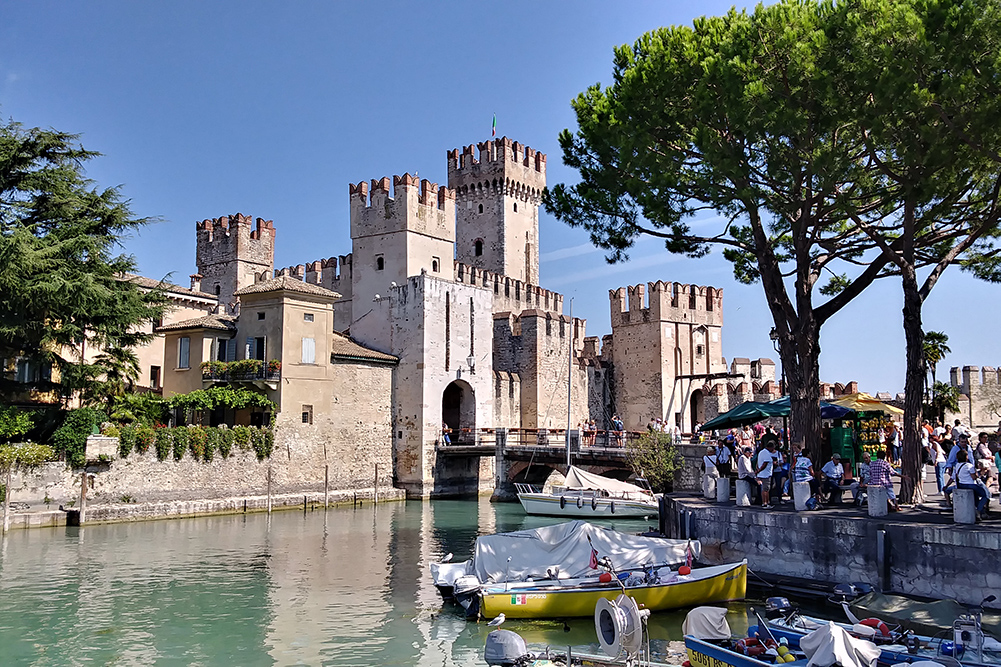
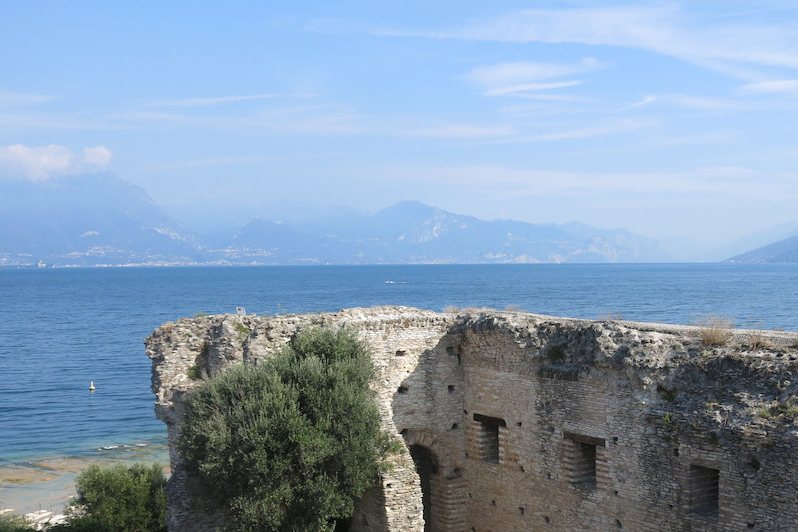
Ready to get on your bike? Read below about your ride of today!
The itinerary of today explores the Southern side of Lake Garda, a territory where the white Lugana wine is produced and where small rolling moraine hills rise. The route leaves Peschiera del Garda back and goes towards the countryside, slightly hilly, cultivated with large vineyards, corn fields and orchards. It follows small country roads, some of which are slightly dirt, and crosses the countryside spotted with ancient rural houses and courthouses surrounded by silence. The route passes by the villages of Pontti sul Mincio and Monzambano, overlooked by medieval castles, then it heads towards Castellaro Lagusello: before getting to the village the track passes close to the lake and then it enters in the village, a good place for a break. After the village of Pozzolengo, The tower of San Martino della Battaglia start to be visible: the itinerary gets more and more close to it until it reaches the high monument on a hilltop. Once there, a little break is suggested: the bar in front of the tower is perfect for a refreshing drink while enjoying the surrounding panorama and a visit to the museum is also advisable in order to learn the history of Italian Independence Wars.
After this restoring break, the route mostly follows flat roads and crosses large vineyards: it will be hard to resist the temptation to stopping by one of the many wineries for a wine tasting! The itinerary heads north until it reaches Lake Garda again. Sirmione is really close, right after the 4 km long peninsula. Once in Sirmione the bikes have to be left out the old town, it is forbidden to enter with the bikes, the village centre is a pedestrian area. Walking is the best way to enjoy the beautiful buildings of the ancient town, its elegant villas and the charming lakeside.
The route finally goes back to Peschiera following a bike path: a small detour to the promontory of Punta Grò is the best ending for those who want to enjoy its beautiful beach or to relax under the shade of high trees.
Ponti sul mincio, monzambano e pozzolengo
Ponti sul Mincio, Monzambano and Pozzolengo are little villages that lie among the moraine hills in the South side of Lake Garda: they all feature medieval castles, panoramic spots where to enjoy beautiful views over the surrounding countryside and small and charming centres where the pace is slow. In Mozambano the majestic church of San Michele stands out and overlooks the river Mincio valley. In Pozzolengo the castle is still inhabited and it is still possible to walk around its narrow alleys.
Castellaro lagusello
This little hamlet stands among the moraine hills and is listed as one of the most beautiful villages of Italy. The village is imbued with a calm and bucolic atmosphere, it is surrounded by fields and faces a little heart-shaped lake. The old town is surrounded by walls and its alleys still preserve the original cobblestones flanked by brick-made houses that give a medieval atmosphere. Castellaro Lagusello is overlooked by the high clock-tower, that lies at the entrance of the village, and also features the beautiful Villa Arrighi, an elegant XIX century villa, visitable on request.
San martino della battaglia
The high monumental tower of San Martino della Battaglia is visible from everywhere in the Land of Lugana. This historical building is 64 meters high and was built in 1880 on the highest hill of San Martino in order to commemorate thousands of victims of the battles during the Italian Risorgimento (Italian Wars of Independence). Here is where the armies of Kingdom of Sardinia and France fought against the Austro-Hungarian Empire on 24 June 1859: the Sardinian army prevailed over the Austro-Hungarian army but with a huge cost in terms of human lives. Inside the tower there is a cycle of frescoes that explains the Italian Independence Wars. From the top of the building it is possible to enjoy a great view over Lake Garda, the Po Plain and the Alps. Nearby the tower there is a ossuary where 1.274 skulls and 2.619 bones of soldiers are kept.
Sirmione
The area of Sirmione, one of the most beautiful villages by Lake Garda, lies at the end of a narrow 4-km-long peninsula. Sirmione has been inhabited since ancient times: stilt houses from Bronze Age were found in its territory, by the lake shore, and it was a important village during Roman time. The Via Gallica, a Roman road that linked Grado with Turin, crossed the territory of Sirmione, and the village developed thanks to that road: the Grottoes of Catullo are important remains from that time.
Sirmione assumed a certain importance also during medieval time: the lords of Verona – the Scaligeri family – built a majestic castle that still guards the entrance of the ancient village. During the domination of Venice Sirmione lost its importance in favour of Peschiera del Garda, as it became a important fortified city. During the next centuries Sirmione was just a little village where inhabitants survived with fishing and agricolture; everything changed by the end of XIX century, when the hot water from the Boiola spring, located in the lake about 300 mt far away from the coastline, was transported by tubes to the village. Thanks to the healing proprieties of the water and the tourism, nowadays Sirmione is one of the most visited villages in lake Garda area.
Scaligero castle
The building of this complex started in 1277 by the Scaligeri family: the castle is a massive fortification surrounded by the water of the lake. From the highest tower of the castle it is possible to enjoy one of the best panoramas over the lake and it is also possible to walk on the patrol walkaway that overlooks the old port.
Grottoes of catullo
The so-called grottoes of Catullo are a Roman villa built during I century BC. Even if there are no grottoes there, they are so called because the local fishermen thought that the great arches that support the building were actually caves. Even if the great poet Catullo lived for a certain period in Sirmione, it is not sure if this villa was his house.
Thermal springs
The thermal water of Sirmione has it origin in Mount Baldo. The water gathers at an altitude of 800 mt, during 20 years it goes 2.100 mt underground and finally it blows out in the lake at around 300 mt far away from Sirmione coastline, at a temperature of about 69°. It has been transported by tubes to Sirmione since the end of XIX century and it has great healing proprieties thanks to it significantly amount of sulphur, in the form of hydrogen sulphide, sodium, bromide and iodine. The water affects the whole body and, in particular, the respiratory, osteoarticular, circulatory, cutaneous and gynaecological systems.
Punta grò
Punta Grò is a small promontory located between Sirmione and Peschiera del Garda. By its shore there is one of the best gravel-made beaches of the lake, interrupted by some roadbeds where ducks nest, and it also features high trees where to enjoy fresh shade during hot summer days.
Terre del lugana
The Land of Lugana is an area located in the Southern side of Lake Garda. The area is mostly flat but its southern section is made of green rolling moraine hills. Lugana white wine is produced here, on a soil that is the remaining of the ancient glacier: the flat side is made of clayish fields rich of mineral salts and its hilly section more sandy and gravelly, that makes the wine less mineral.
Lugana wine
Lugana is a white wine made of indigenous grapes called Turbiana (Trebbiano di Lugana), in quantity not inferior of 90%. It can be produced also as Superiore, made of selected grapes aged for at least for one year (in wooden barrel of steel tanks), and Spumante (sparkling, charmat of classic method). It perfectly matches with light starters, lake fish and soft cheeses.
Lake fish
Lake fish is ever-present in every local restaurant. During cold seasons warm fish soups are unmissable and during summer time the main course is grilled fish. The most common fish are the lavarets, pikes, tenches, perches, bleaks and trouts, also served with pasta or polenta.
Sausages of the moraine hills
The area of the moraine hills and the province of Mantua is famous for the sausage production, especially the salame morenico of Pozzolengo. It is particularly appreciated for its digestibility and light and delicate taste and it is made of pork not younger then nine months.
Fresh pasta
In the province of Mantua some particular kinds of pasta are produced. Capunsei are typical dumplings made of grated bread, stir fried with butter and kneaded with hot broth and finally served with butter, sage and Parmigiano cheese. Tortelli di zucca is fresh pasta filled with pumpkin, amaretto cookies, nutmeg, egg and parmigiano cheese.
Bike tour 2 • Bardolino
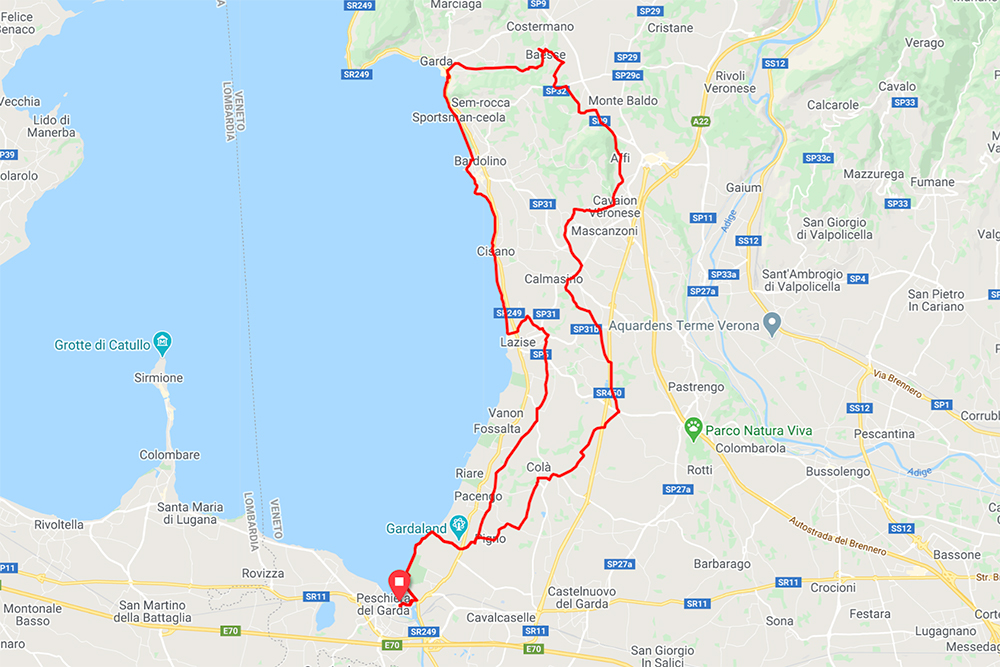
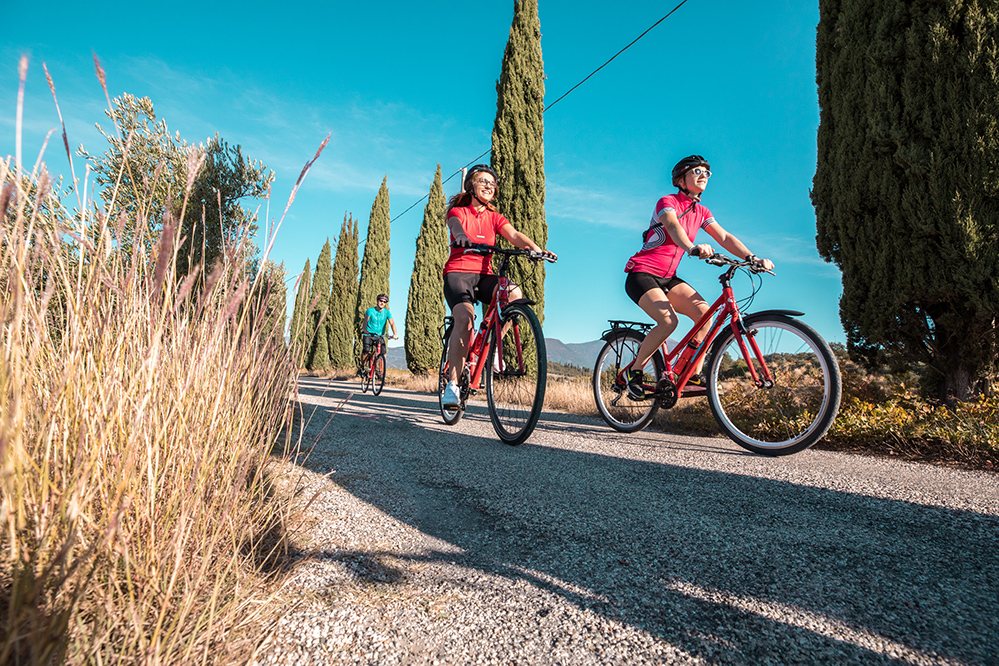
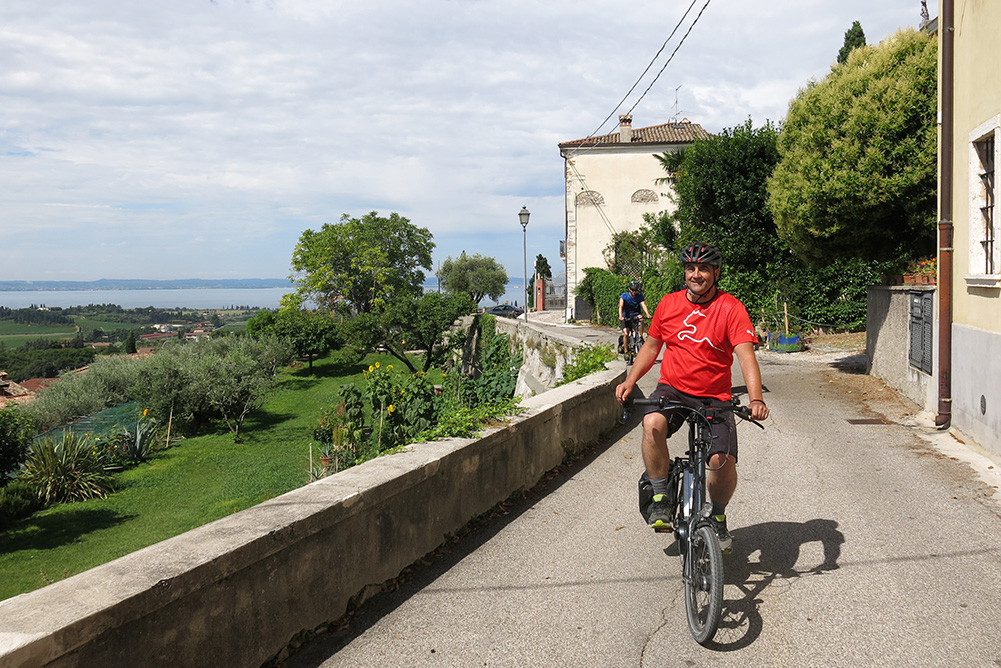
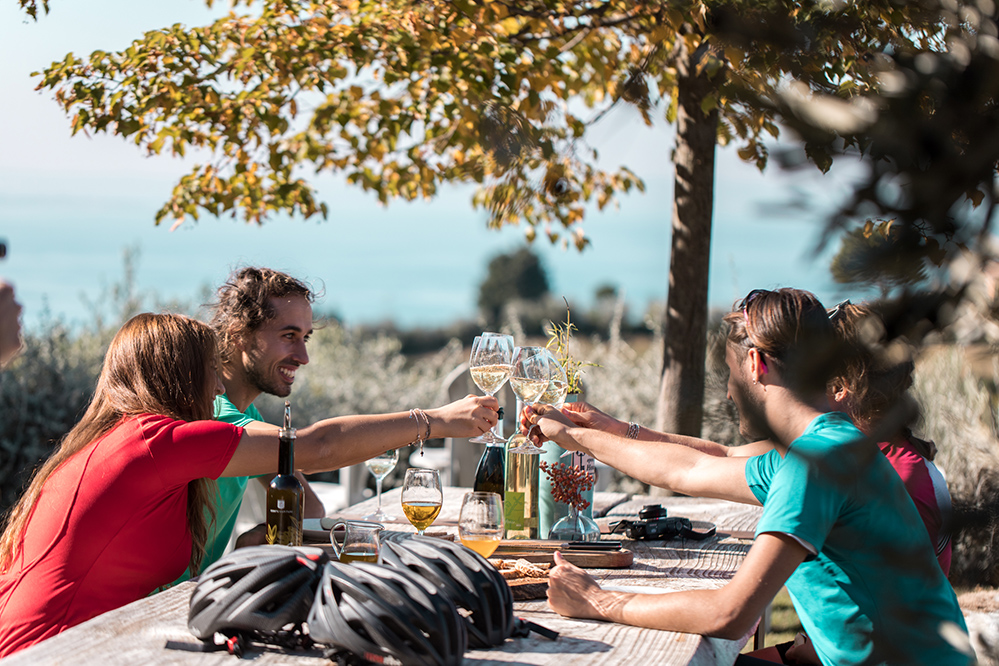
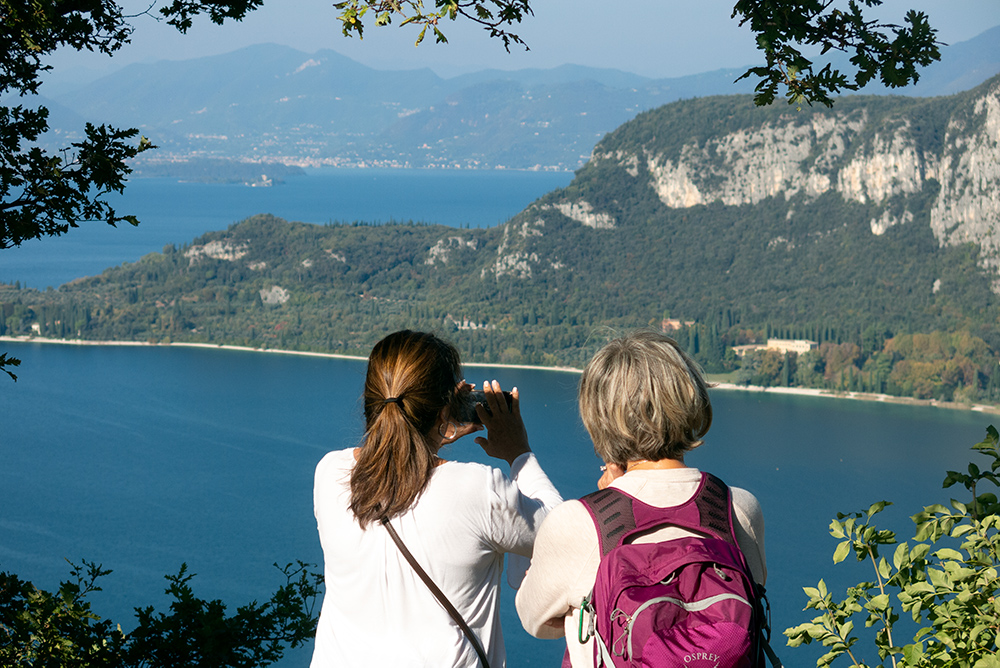
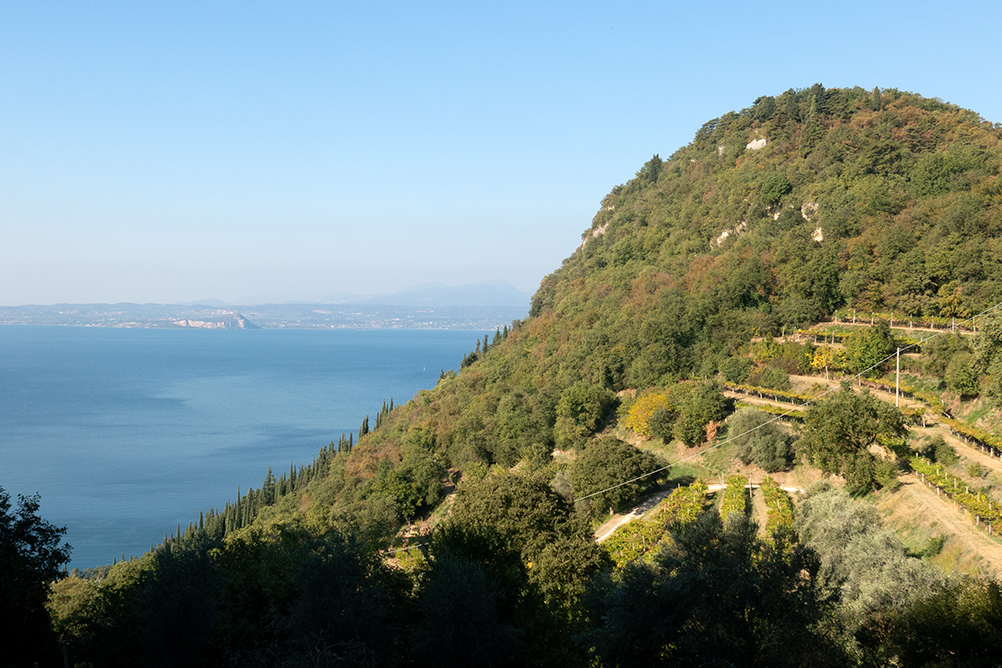
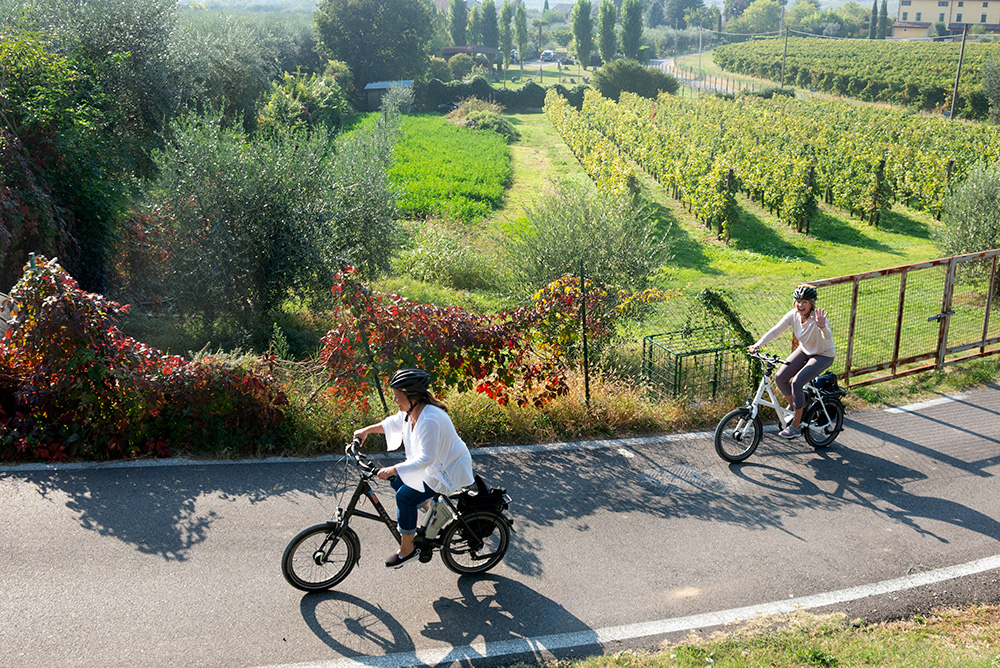
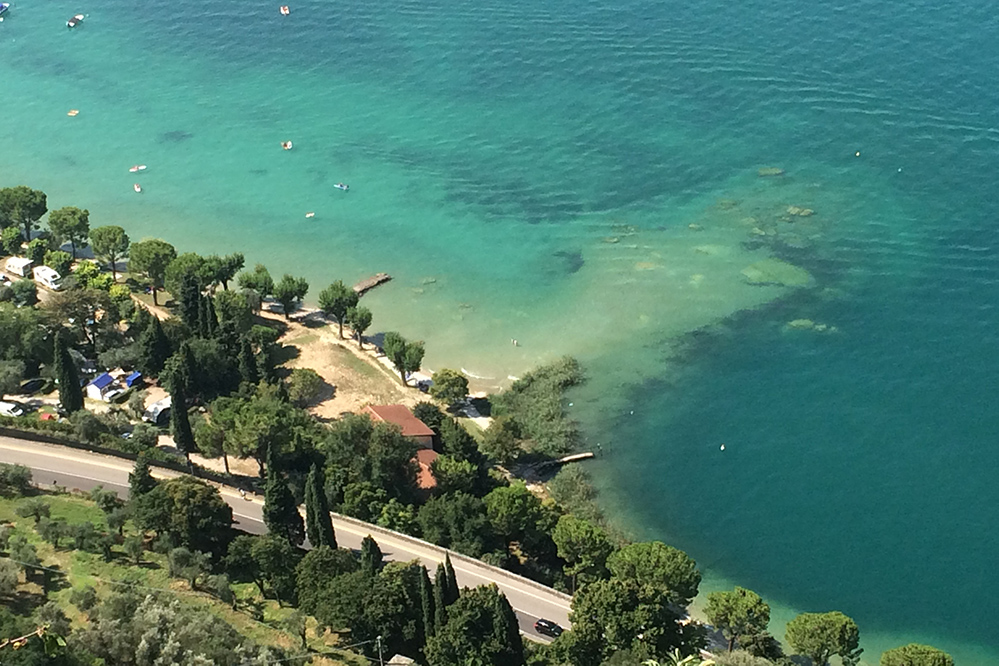
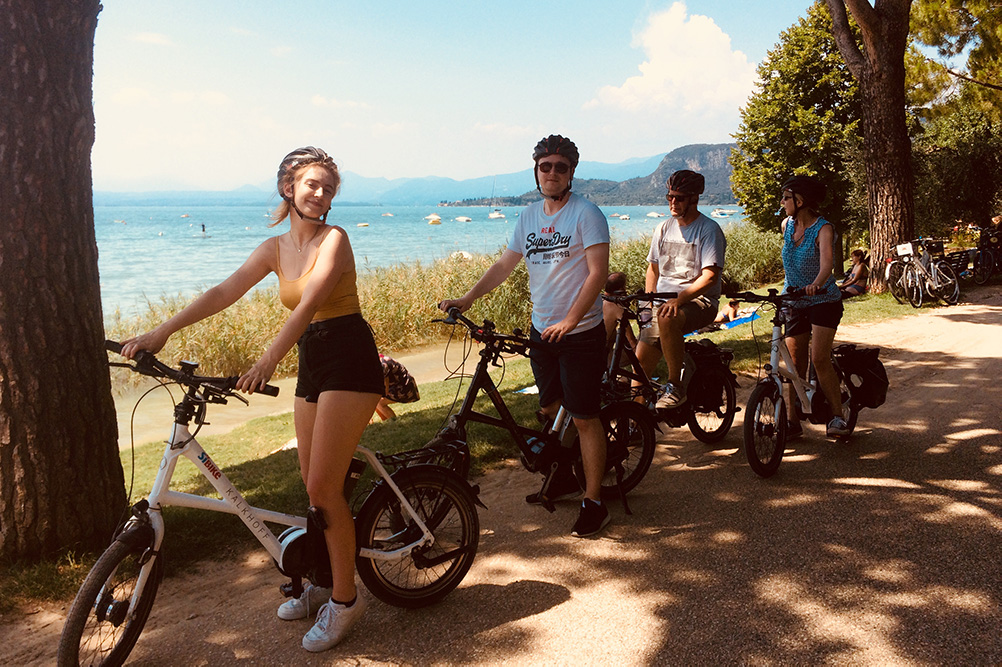
Ready for day two? This time you’ll ride East…
This route explores the Eastern side of Lake Garda, its beautiful hills and charming villages. It initially follows the lake side along a bike path that flanks the blue water of the lake, then it heads inland, where the moraine hills are covered with large vineyards and olive trees, but also kiwi orchards and other fruit trees. The itinerary crosses the small hamlet of Colà, famous for the hot springs, and then goes slightly up and down the hills until Calmasino, from where one can enjoy a beautiful view over the lake. The route follows beautiful roads immersed in large vineyards and flanked by elegant and high cypresses and gets close the hills of Cavaion Veronese, then a short but demanding road up brings to the church square: take a break after the climb, the view from there is great! After cycling downhill, the itinerary gets to Affi, that features a small but beautiful old town, and Pertica, a well-preserved medieval hamlet, then crosses large cultivated fields on gravel roads and it finally gets to the lake by the village of Garda, surrounded by green hills and enclosed in a romantic bay. Once there, take time to visit the ancient village that faces the lake: park the bikes and walk around the narrow medieval alleys flanked by typical shops and food stores and along the romantic lakefront, on which some elegant historical building face.
The itinerary follows the lakefront under the shade of high cluster pines, it crosses the small villages of Bardolino, Cisano and finally it gets to Lazise. A break in Bardolino and Lazise is recommended, the old towns are charming and both feature romantic ports and buildings that date back to medieval time. The itinerary finally gets back to Peschiera following inland roads that offer great views over the lake.
Colà
Colà is a small village on the moraine hills, famous for the hot springs of Villa dei Cedri, a XVIII century villa that features a large park with a great variety of plants, mostly cypresses and cedars. The hot springs were recently discovered: in 1989 two spring with a temperature of 36° and 42° were casually found after some works for improving the watering system. The hills around Colà are great for some nice walks.
Affi
Affi is famous for being the crucial point for car traffic to Lake Garda: besides of large malls, fortunately Affi still has a well preserved old centre with cobbled streets, elegant villas and a beautiful stone-made wash house where fresh water still flows. It lies at the bottom of the lush Mount Moscal, which high cliffs dominate the village. Hidden tunnels run for miles inside the mountain: it was a former Nato bunker called West Star, that was operative during the years of the Cold War.
Cimitero militare di Costermano
The bodies of 22.028 German soldiers fallen in various battles in Northern Italy during World War II lie in the military cemetery of Costermano. It is built on a green hill on which top a 8-meters-high cross stands, where it is possible to enjoy a good view over lake Garda. It is a place of peace and tranquillity and the best period to visit it is during the months of March and April, when the heather flower is in bloom and everything is purple-coloured.
Garda
The village of Garda lies on the coast of a little gulf protected by green hills and it is one of the most charming places of Lake Garda. It features a charming centre with some elegant buildings, such as Palazzo dei Capitani, that dates back to the period of the Venetian domination. The majestic Villa Albertini and Villa Canossa stand out: the best view over these buildings is from the lake or from the promenade towards Punta San Vigilio. La Rocca is another unmissable place: in this promontory overhanging the lake there used to be a fortress built by the Lombards. Warda was the name given by the Lombards to the fortresses and it’s from that world that the name Garda derives from. La Rocca is reachable by walking on a demanding path but don’t give up: the view from the top of the hill is amazing! Punta San Vigilio is one the most romantic spots of Lake Garda and along the promenade to reach it there is one of the best pebble-beaches of the area. The small peninsula has been chosen as one of the preferite destinations by many famous people, such as Winston Churchill and the tsar Alexander II, as well as poets and artists that praised its beauty. Nowadays the villa, the little church, the restaurant, the port and the fascinating Baia delle Sirene (the Siren’s Bay) are owned by the counts Guarienti di Brenzone: if you can afford the price, a lunch in the restaurant will be unforgettable.
Bardolino
Lively village on the eastern shore of Lake Garda, Bardolino is famous for the production of red wine and extravirgin olive oil. The area has been constantly inhabited since the III millennium b.C.: in its territory it is possible to find traces of a pile-dwelling civilisation, but the most ancient remains that one can find in the village are dated back to the medieval time (from Langobard to Scaligeri time). There are still some sections of the ancient walls that used to surround the village. Very important for the development of the village were the Colombaniani monks, that evangelised the area and improved the agricolture: vineyards and olive groves are still the main cultivations of the area. Among the churches, San Severo church stands out with remarkable frescoes and a medieval crypt. Not-to-be-missed is the local market on Thursday morning, where the streets are invaded by colourful stalls full of local products and clothes. The walk along the lake is also unmissable, among colourful flowerbeds and elegant villas. For food and wine lovers, in its territory there are many famous wineries, as much as oil mills and a interesting olive-oil museum in the little hamlet of Cisano.
Lazise
The village of Lazise is surrounded by high medieval walls and features many charming little alleys, an ancient port where the fisherman boats are still moored, and a great castle built by the Scaligeri, now included in the park of a private villa. In 983 it was the first Italian free commune, not subject to the feudatory, a sort of independence from the Sacred Roman Empire. The promenade on the lakeside towards Bardolino is one of the best on the eastern shore. Don’t miss a walk in the small alleys of the village, where colourful houses are flanked by shops and restaurants.
Bardolino wine
Bardolino is a red wine produced in the Eastern side of Lake Garda. Corvina, Rondinella and Molinara are the grapes used for this wine, the same for Valpolicella wine. The difference is made by the climate, that is milder near the lake, and the soil, that here is made of moraine sediments. Bardolino is a easy-to-drink wine, perfect for first courses, meat-based courses, risotto, white meat and barbecues. The Superiore version needs a 12 months ageing and the Chiaretto, the rosè version, is perfect as aperitif or matched with fish: a Chiaretto spumante version (sparkling) also exists.
Extra virgin olive oil
The hills of both sides of Lake Garda are covered with olive trees, some of them are centuries-old. The extra virgin olive oil here produced is excellent, there are many varieties of olives and many oil mills. The most common olive varieties are Frantoio, Leccino and Casaliva, that impart a naturally delicate flavour that smells fresh grass, herbs, hay and artichoke, with an aftertaste of almond and low acidity. Garda olive oil is a DOP (denomination of protected origin).
Bigoli con le sarde
Bigoli are a fresh homemade pasta, similar to spaghetti but thicker and rougher as they have to hold the sauce. They are typical from Veneto region and in the lake area they are served with a sauce made of the local fish, the sarda (Alosa Agone).
San vigilini
Typical butter cookies with raisins, created by the innkeeper Leonard Walsh for Winston Churchill, that was hosted in Punta San Vigilio after a trip to Venice.
Bike tour 3 • Custoza
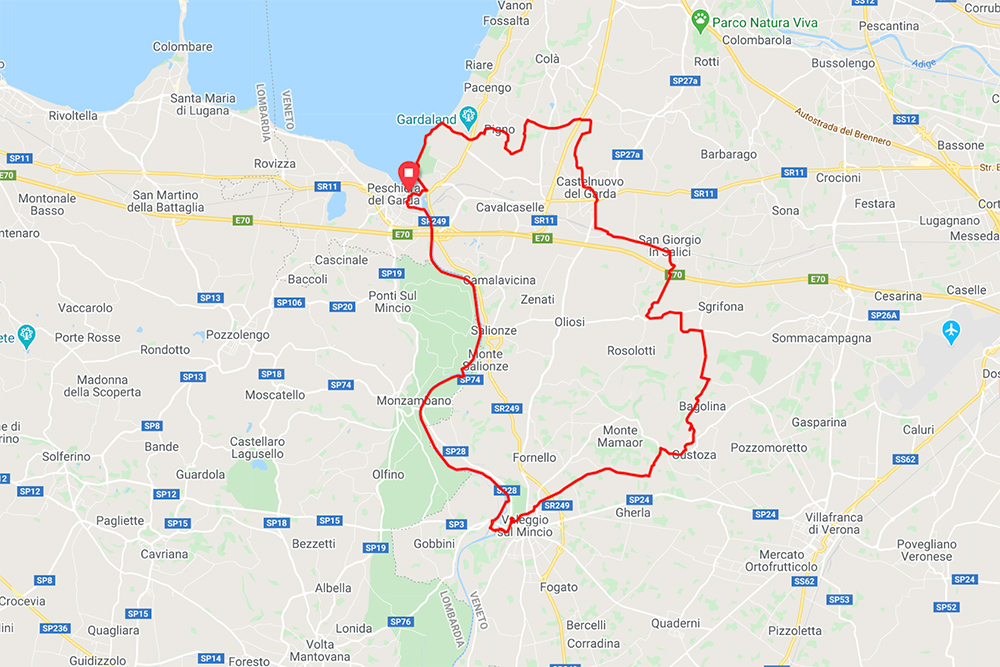
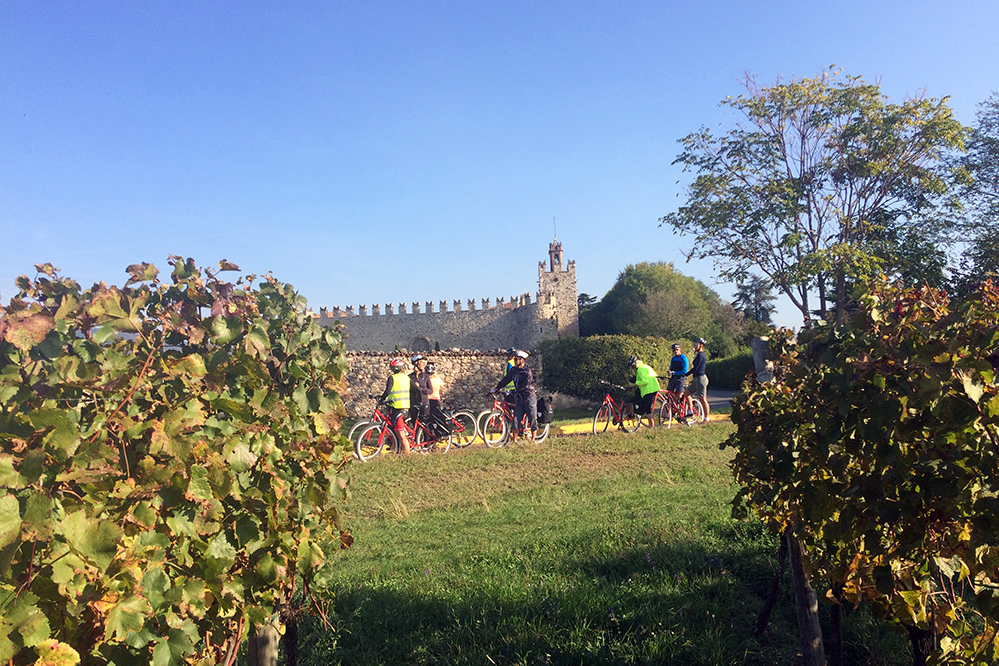
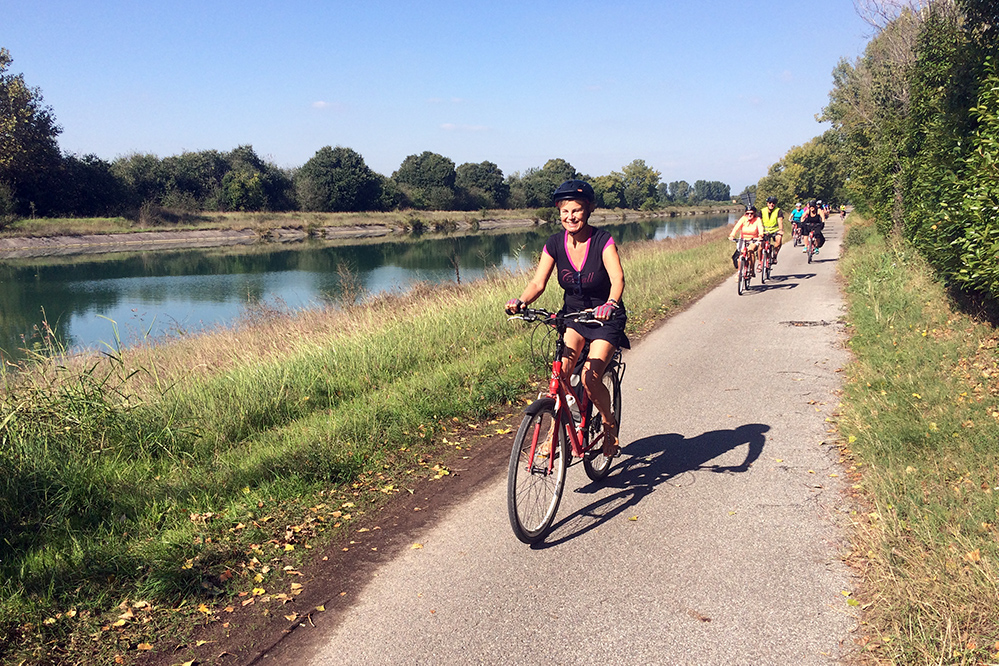
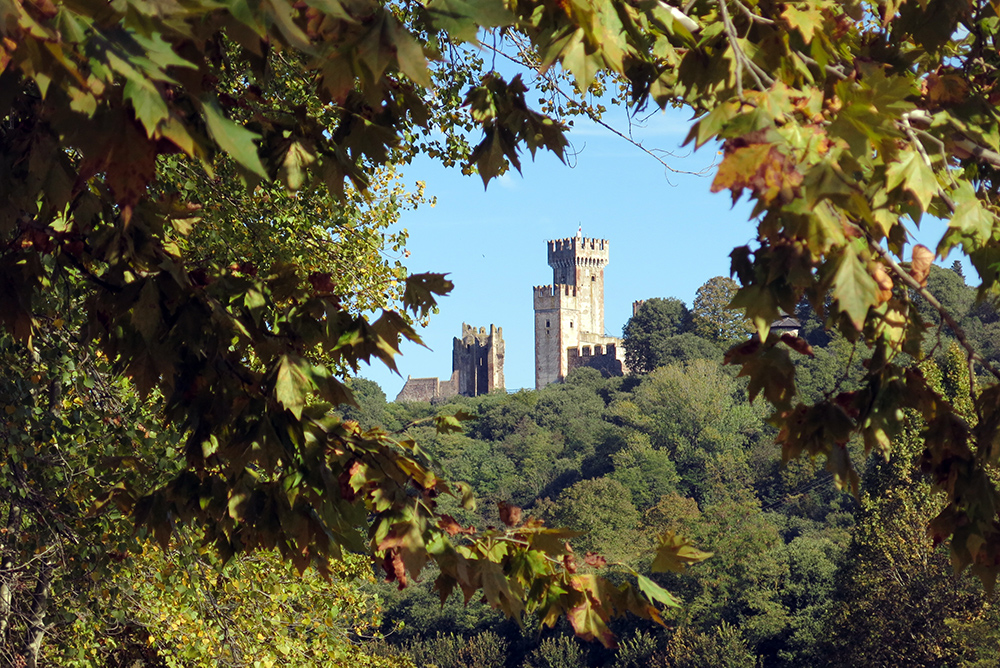
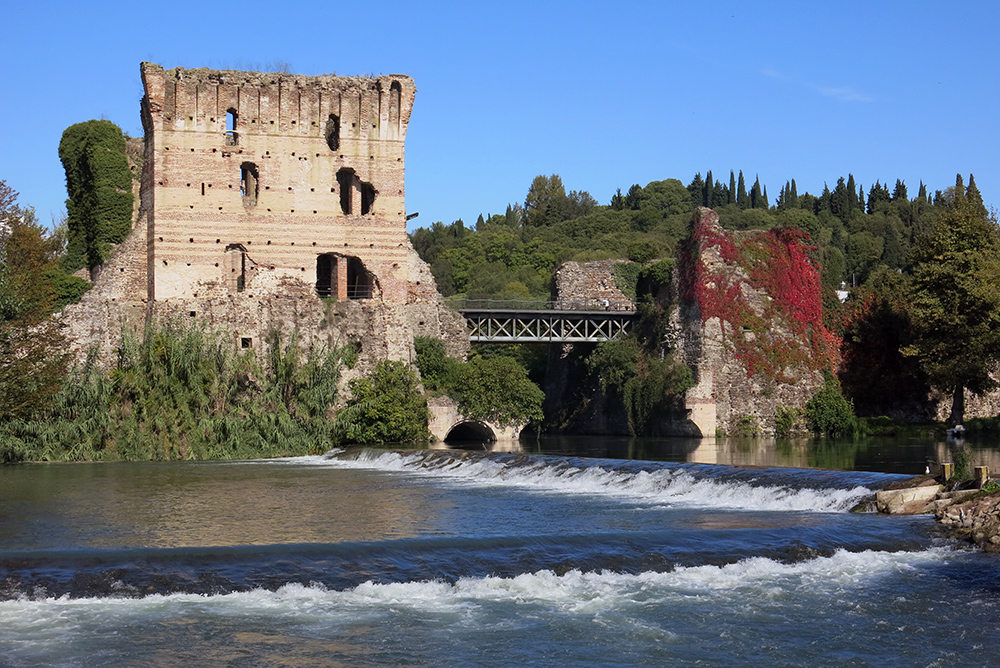
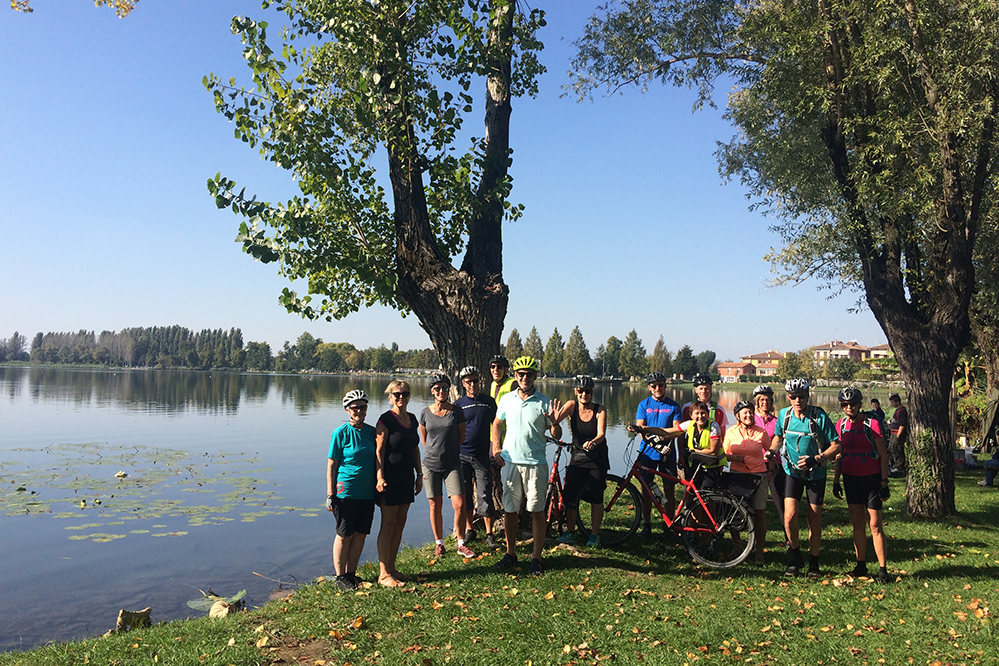
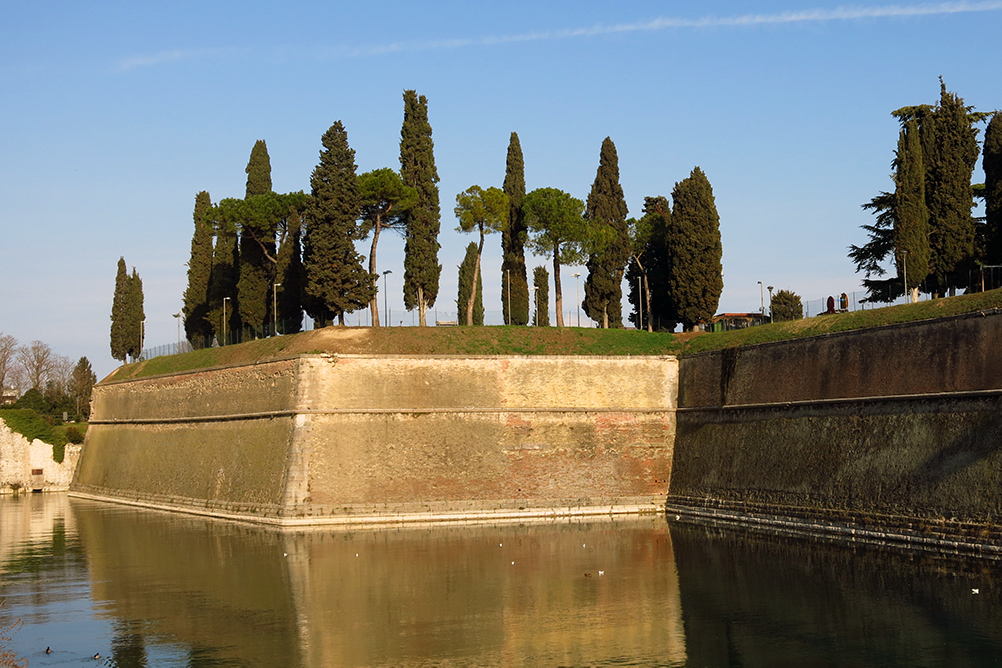
Hop we go!
The area of Custoza is off the beaten tracks, even if it is really close to Lake Garda, and it still preserves the authentic rural atmosphere of the Veronese countryside. The territory is slightly hilly and is covered by cultivated fields with large kiwi and peach orchards, as well as the omnipresent Custoza vineyards. The itinerary initially flanks the lakeside and then goes inland, an area where the pace is slow and where just few villages lie: it crosses the villages of Castelnuovo del Garda and San Giorgio in Salici, then it goes deep into the area of Custoza. A short and panoramic climb, slightly demanding, brings up to the hilltop where the Ossuary of Custoza lies: from there the view over the surrounding countryside is amazing. The village of Custoza is the perfect place for a relaxing break and a refreshing drink. After a fast ride down, the route crosses the countryside again, following roads flanked by many peach trees: on springtime the trees are in bloom and riding there is spectacular. After the ride on the countryside the itinerary gets to Valeggio sul Mincio, which castle’s characteristic shape is visible from far away, standing on the top of a hill. A break by Borghetto sul Mincio is really recommended: it is a pleasure to walk around this small group of houses that lie at the river Mincio sides, the atmosphere is really romantic and it is the perfect place where to taste the typical tortellini.
The way back to Peschiera del Garda is along the river Mincio bike path, that follows the river that flows among green and fascinating moraine hills.
Castelnuovo del garda
Castelnuovo del Garda is a village that lies among the moraine hills on the Eastern side of Lake Garda. The village centre is not particularly charming and the real attraction of Castelnuovo del Garda is Gardaland, the most famous amusement park in Italy. Together with the aquapark Caneva World and Movieland Studios, it attracts thousands of tourists every year.
Custoza
Custoza is a little hamlet that lies on the top of a hill, surrounded by large vineyards of the homonymous white wine. Custoza is famous for two battles fought during the Italian Independence Wars, the first in 1848 and the second in 1866, both against the Austrian Empire and both won by the Austrians. The village is charming, there are some beautiful panoramic spots and a few elegant Venetian Villas, such as Villa Pignatti, built in XVII century. The hilltop is dominated by a 40-meters-high obelisk, a ossuary built in 1879 where the bones of Italian and Austrian soldiers died during the Independence Wars lie. The view from the top of the tower is really nice and ranges from the Prealps to the Po Plain.
Valeggio sul mincio
This lively town that lies between the plain and the hills is mostly famous for its typical tortellino, here called Nodo d’Amore – literally “love knot” – a delicacy for which the people from Valeggio are really proud.
The area of Valeggio has been inhabited since the Bronze Age as it lies in a strategical position, close to a ford over the river Mincio. During medieval time the village was part of a great system of fortifications called Serraglio, about 13 km long, that linked the river Mincio with the territory of Villafranca.
Valeggio sul Mincio summons many visitors also thanks to the famous Parco Sigurtà and the little hamlet of Borghetto sul Mincio.
Scaligero castle
A long staircase from Borghetto sul Mincio or a easier path from Valeggio sul Mincio bring to the Scaligero Castle, built on a hilltop. Built by the Scaligeri family in XIII century, only the main walls and the tower still remain, but the view that one can enjoy from the large courtyard or from the top of the tower (if open) worths the effort to reach the castle.
Parco sigurtà
This beautiful park, just 5 minutes from Valeggio, is a huge garden where it is possible to enjoy many different kinds of flowers, forests, boxwoods, small lakes and a labyrinth: tulip blossom in springtime and rose blossom on May are some of the best moment to visit the park. The park is accessible also by bike, as it is 560.000 m² large it is the perfect way to visit it. Next to the park Villa Sigurtà lies, a private building built in XVII in neoclassical style.
Borghetto sul mincio
Borghetto sul Mincio is a tiny village that lies at the shores of river Mincio and it is listed as one of the most beautiful villages in Italy. The village was founded on a strategical spot, close to a ford over river Mincio, and that’s why it assumed importance for many centuries. The village is charming and romantic and features some ancient watermills among its narrow alleys, used in the past for wheat milling and rice husking. For selfie lovers, the best pictures are taken from the Visconteo Bridge. A walk in the park at the top of the central island is suggested during hot summer days, the shade under the high trees and the breeze from the river are really refreshing.
Ponte visconteo
The bridge was built by the Visconti family, lords of Milan, at the end of XIV as a bridge-dam. The festival “Festa del Nodo d’Amore” takes place on the bridge every year by the end of June in order to celebrate the typical tortellino. It is a huge banquet with a 650 mt long table where more than 900.000 tortellini prepared by the Restaurateurs Association of Valeggio sul Mincio are served to more then 4.000 participants: the party ends with pyrotechnical games shot from the Scaligero Castle.
Fiume Mincio
River Mincio is the main outlet of Lake Garda and is the last tributary river on the left side of river Po. The river starts from the south-eastern tip of the lake at the town of Peschiera del Garda and then flows among the moraine hills, crosses Borghetto sul Mincio and reaches the Po Plain. After about 65 km it gets to Mantua, where it forms a series of three lakes that skirt the edges of the old city and that on summer time are covered with colourful loto flowers: the lakes are not natural but were created in XII century (they were originally four). The river ends into the river Po after 75 km.
River Mincio bike path
This bike path runs along the river Mincio and links Lake Garda with the city of Mantua and finally gets to river Po. It is 43,5 km long and some of its sections runs on the old railway Mantova – Peschiera del Garda, dismissed in 1967.
Salionze
This little hamlet lies some miles north of Valeggio sul Mincio and is famous for being the place where Attila, king of the Huns, and Pope Leo I the Great met in 452: the apparition of the Saints Paul and Peter drawing the swords convinced Attila the Hun to retreat.
Custoza wine
Custoza is a white wine, smooth and delicate, which centre of production is the village of Custoza and the surrounding area, including some areas around Lake Garda. It is mainly made with Garganega, Trebbianello and Bianca Fernanda grapes. It perfectly matches with light meals, starters, aperitifs, first courses and fish. It is labelled as DOC since 1971.
Fruit and vegetables
The territory crossed by the itinerary is mainly cultivated. Besides of the vineyards, there are many kiwi and peach orchards: during spring time the peach blossom is amazing, everything is coloured with pink and white. Among the vegetables, the Custoza variety of broccoli is largely produced in the area.
Tortellini di valeggio
Tortellini di Valeggio are made of really thin dough, as thin as a veil, filled with home-made braised meat (beef, chicken, veal and pork) and spices, better served with golden melted butter, sage leaves and a handful of grated Parmigiano cheese or broth. These tortellini are commonly called as Nodi d’Amore (love knots) because of a legend that dates back to XIV century: the nymph Silvia and the soldier Malco left a knotted yellow-silk handkerchief by the shore of river Mincio as a love token, after a fight against the Visconti soldiers.
Sfogliatine di villafranca
The puff pastries of Villafranca, a town famous for its large Scaligero castle, are renown for their lightness and fragrance, they are ring-shaped and the recipe is still the original one invented in 1870: the ingredients are simple, just water, flour, butter, salt, sugar and eggs, but the final product is unforgettable.
Problems or doubts?
We’re here for you!
Elisa/Francesco +39 328 0280 174
Motocicli Ardielli, Via Venezia 66, Peschiera del Garda • www.motocicliardielli.it • +39 (0)45 7550124
Highroad Bike Shop, Via Bell’Italia 31, Peschiera del Garda • www.highroadbike.com • +39 (0)45 4852811
Bike’n Foot Store, Via XXX Maggio 5, Peschiera del Garda • www.bikenfoot.it • +39 (0)45 5118248
Garda Gravel, Via Venezia 19, Peschiera del Garda VR • www.gravelclub.it • +39 351 828 4462
Ciclosprint Bonfante, Via Enrico Fermi 1, Ponti sul Mincio MN • +39 (0)376 800882
Il Ciclista di Sirmione, Via Brescia 23, Sirmione BS • www.ilciclistadisirmione.com • +39 (0)30 9905936
Sirmio Trans, Viale Guglielmo Marconi 39, Sirmione • www.sirmiotrans.it • +39 (0)30 8362068
Dieffebici Punto Rosso, Via Fra Castoro 2/13, Cavaion Veronese • www.dieffebici.it • +39 342 3943799
Bike Store, Viale della Repubblica 6/a, Costermano • www.bikestorefun.com • +39 (0)45 6201250
Cicli Bertasi, Viale della Repubblica 7, Costermano • www.ciclibertasi.com • +39 (0)45 7200594
Bella Bici, Via Don Gnocchi 41/B, Garda VR . www.bellabici.bike • +39 366 9365806
Bike Shop Garda Service, Corso Italia 40, Garda VR • +39 338 9218071
100% Bike, Via Croce 25, Bardolino VR • www.centoxcentobike.it • +390391 4389391
Cicli Degani, Piazzetta Beccherie 13, Lazise VR • www.ciclidegani.it • +39 (0)45 6470173
Los Locos, Via Gardesana 71, Lazise VR • www.loslocosbikeshop.com • +39 (0)45 7581349
Ri-Bici, Via Foroni 66, Valeggio sul Mincio MN • +39 350 0953676